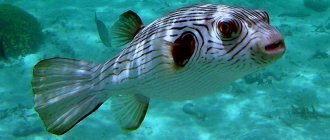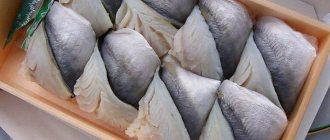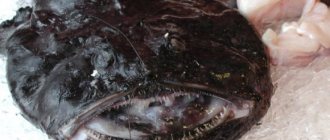He who eats puffer fish is a fool, and he who does not eat it is an even greater fool. This Japanese proverb literally describes the attitude of the indigenous people towards their deadly delicacy. And foreigners visiting Japan are willing to pay crazy amounts of money to experience the dangerous balancing act between life and death. They say that once you try this fateful dish, you become attached to it forever. Thrill-seekers are not stopped even by the fact that every year about fifteen people die from eating this fish. To experience the narcotic effect of fugu, you need to shell out about $1,000 in a specialized restaurant in Japan, where you will have to put your life in the hands of a professional chef.
a brief description of
In fact, fugu is the name of a traditional dish that is so valued in Japan. And the fish, which is now also called, is the brown rocktooth [1]. You can often hear such names as dog fish, puffer fish, fahak, diodont. This is a relatively small fish of the pufferfish family [2][3]. The length of its body can reach 80 cm, but usually it is 45 cm. This fish does not have scales as such. Instead, fugu has thin, light skin that has the ability to stretch. This structure is not accidental: in this way the rocktooth protects itself from predators. The fact is that in moments of mortal danger, the fish absorbs a large amount of water and swells, forming a ball completely studded with sharp spines. If suddenly a shark dares to dine on this fish, then the swollen, prickly ball gets stuck in the throat, and the ill-fated predator dies.
Content:
- a brief description of
- Habitat and reproduction
- A little history
- Composition and beneficial properties
- Use in cooking
- Application in medicine
- Dangerous properties of fugu fish
- Symptoms of poisoning and first aid
- conclusions
But the worst thing about this fish is not its appearance. Her skin and internal organs contain a deadly poison - tetrodotoxin. This is a neuroparalytic poison that begins to act in the human body approximately 10 minutes after ingestion. There is no antidote for this toxin and, unfortunately, in most cases of poisoning a person cannot be saved.
Interestingly, the fugu fish itself is not initially poisonous. Dangerous poison begins to accumulate in it during life [4]. It enters the rocktooth along with food, which consists of various organisms containing small amounts of tetrodotoxin. Once in the body of a puffer fish, it settles in the liver and ovaries and is transported through the bloodstream to the eggs, intestines and skin, making it one of the most poisonous fish on the planet. This powerful neurotoxin has harmful effects even in small quantities. For a person to die, only one milligram of tetrodotoxin will be enough. Each fugu fish contains enough neurotoxin to kill dozens of people.
Natural enemies
The poisonous puffer fish is rightly considered to be the worst enemy of fishing, because other aquatic inhabitants rarely coexist with small representatives of the genus ray-finned fish from the family of pufferfish and the order of pufferfish. Reliable protection for takifugu from predators is its ability to swell into a ball with spikes, as well as toxic meat. It is for this reason that aquatic inhabitants who hunt most other fish prefer to avoid the poisonous puffer.
Habitat and reproduction
This fish loves the coastal areas of the brackish waters of the Pacific Ocean. It is widespread in the Sea of Okhotsk, in the waters of the Japan, East China and Yellow Seas. Adult fish are found at a depth of no more than 100 meters. The fry can also be seen at the mouths of brackish rivers, and as they mature, they move further from the coasts into the open seas. Fugu spawns in the spring, attaching eggs to rocks in quiet places at shallow depths (about 20 meters). Skalozub is a shallow-water fish; it loves small sea bays and calm waters.
Inimicus
Inimicus are poisonous ray-finned fish of the scorpionfish family. They reach a length of 25 cm. The body is partially covered with scales. Inimicus are predators that burrow into the sand to hunt. This is how they ambush worms and crustaceans. According to National Geographic, people often step on camouflaged fish, which pose a deadly threat. Near its dorsal fin there are spines with a neurotoxin.
Inimicus: Wikipedia
A little history
In different countries this fish is called differently: in England - spherical or balloon fish, in Spain - boteta, in the Hawaiian Islands - maki-maki, and in Japan the most famous fish is fugu.
This fish has been known for quite a long time. Mention of it was found in Ancient Egypt: one of the drawings found on the tomb of the pharaoh of the Ti dynasty was very reminiscent of a fugue. At the same time, eastern sages wrote in their chronicles about its terrible poison. The very first Chinese medical “Book of Herbs”, written around the third millennium BC, also contains information about puffer fish.
In Japan it has been known and appreciated for a very long time, but in Europe it became known in the 17th century, thanks to trade relations with eastern countries. The Dutch physician Engelbert Kaempfer, while in Japan at the end of the 17th century, mentioned that some fish, when consumed, contain a lethal dose of poison, but this does not prevent the Japanese from eating it, throwing out the entrails and thoroughly washing the meat. He also talked about how Japanese soldiers were subject to serious sanctions for eating this fish. If one of the warriors died from fugu poisoning, then his son lost all the rights and privileges of his father entitled to him by law.
The famous captain James Cook also suffered from this fish. During his trip around the world, he landed on one of the islands, where one of the crew members exchanged a strange unknown fish from a native. It was decided to cook it for dinner. By this time, two guests were invited to the ship, who were supposed to describe and sketch the find. This took quite a long time, so the captain and the guests barely touched the food they served. They were incredibly lucky, since they served the liver and caviar of puffer fish, which contain a colossal amount of tetrodotoxin. The sailors escaped with a slight fright: weakness, loss of consciousness, slight numbness of the limbs. But one of the crew members who ate the entrails was not so lucky. In the morning he was found dead.
By the way, not so long ago in Japan there was an old unspoken law, the essence of which was that the cook who prepared the dish and poisoned the visitor was obliged to eat it himself or commit ritual suicide - the so-called seppuku or hara-kiri.
Who needs this?
The most important mystery of fugu is why people take mortal risks. Fans of extreme cuisine claim that the taste of pufferfish is reminiscent of Japanese silk paintings - something refined, elusive and smooth. Kitaoji Rosannin, the creator of the delightful pottery, wrote: “The taste of this fish cannot be compared with anything. If you eat fugu three or four times, you will become a slave to fugu. Anyone who refuses this dish for fear of dying deserves deep sympathy.” In addition to its incredible taste, fugu is believed to have a narcotic effect. The trick when preparing pufferfish is to leave just enough poison to give the eater a feeling of mild euphoria. Gourmets who have tried this fish claim that as the dish is consumed, a paralyzing wave rolls in: first the legs are taken away, then the arms, then the jaws. Only the eyes retain the ability to move. However, after a moment everything comes to life: the power of speech returns, arms and legs begin to move. Related to this is the third reason why the Japanese love fugu so much. It's all about a special attitude towards death. The samurai also believed that passing away from life is the apotheosis of beauty. Fugu allows you to touch the Japanese understanding of perfection and, with a successful combination of circumstances, return back. Not long ago, extremely proud scientists announced that they had bred a non-poisonous pufferfish. It turns out that the secret was in the natural diet of the fish. Fugu does not produce toxic substances in its own body - it becomes toxic by eating poisonous starfish and shellfish. If you put a puffer fish on a diet from birth, you will get a completely safe inhabitant of the deep sea. However, the expected sensation did not happen. After all, without its toxin, the puffer fish becomes just another type of fish - quite tasty, but not anything special. It is not for nothing that it is in the spring, when fugu is considered the most poisonous, that gourmets pay the highest price.
Composition and beneficial properties
In terms of its chemical composition, fugu is practically no different from other representatives of this class. It contains a unique vitamin and mineral complex. Its energy value is approximately 108 kcal. It contains protein that is easy for the body (16.4 grams) and about 2 grams of fat.
The neurotoxin contained in it in huge quantities is used in medicine to prevent certain diseases and have a long-term analgesic effect.
Despite the deadly poison in its composition, this fish is in great demand in cooking. Those who like to “tickle their nerves” shell out considerable sums to try this unsafe dish.
At the moment, there is an artificially bred type of fugu that does not contain a dangerous toxin, but it is not at all popular. The most valuable things about it are the thrill, the emotional outburst and the huge surge of adrenaline that accompany eating fugu. Some even consider eating such fish a kind of Russian roulette.
Use in cooking
In 1958, Japan passed a law stating that a cook who plans to work with puffer fish must have a special license. To obtain it, the applicant must pass two exams: theory and practice. A larger number of candidates are eliminated after the first stage. To successfully complete it, you need to know everything about the different varieties of pufferfish and remember all the known detoxification methods. To pass the second stage and obtain a license, the chef must eat the dish he has prepared.
Cutting fugu is a delicate and jewelry art, which only a few master [5]. To do this, you need to cut off the fins with quick and precise blows, separate the mouthparts, and use a sharp knife to open the belly of the puffer. Then, carefully so as not to tear, remove the poisonous entrails and dispose of them. Then the fish fillets are cut into thin transparent slices and washed thoroughly under running water to get rid of traces of blood and poison.
A set lunch in such a restaurant consists of several dishes. As a cold appetizer, fugusashi is served - a unique dish of the thinnest mother-of-pearl slices of fugu, laid out in the form of intricate patterns: butterflies, birds, and so on. They are eaten by dipping in ponzu (a specially prepared sauce with vinegar), momiji-oroshi (grated Japanese daikon radish) or asatsuki (finely chopped chives). After this, the first dish is brought - fugu zosui. This is a soup made from boiled fugu and rice with the addition of raw egg. The second course consists of fried pufferfish.
Serving fugu fish dishes also has its own sacred ritual. So, for example, the less poisonous back pieces are served first, moving closer and closer to the most poisonous part of the fish - the belly. The cook must monitor the guests, assessing their condition also from a medical point of view, in order to stop possible consequences in time and not allow them to eat more than the norm.
The superiority and skill of the cook lies in leaving a small dose of poison in the fish, at which restaurant visitors experience something similar to drug intoxication and fall into a slight euphoria. Those who have tried this treat report that in the process of eating such a dish, a slight paralyzing effect is felt, which manifests itself in a slight numbness of the arms, legs and jaw. It lasts a few seconds, but during this time, the person experiences a storm of emotions, balancing on the edge of life and death. They say that many who have at least once experienced these feelings are ready to risk their lives to repeat this moment [6].
A drink is made from the fins of the pufferfish, after which all senses are heightened, a hallucinogenic effect and slight intoxication appear. To do this, charred fugu fins are dipped in sake for a minute. Visitors are required to drink this drink before eating deadly fish dishes.
Wart
The warty fish, or stone fish, is a poisonous predator of the scorpionfish family with a body 30–40 cm long. The color from brown to green performs a good camouflage function.
The fish lives in the tropical waters of the Indian and Pacific oceans, from the Red Sea to Australia. It can be found in the shallow waters of the resorts of Hurghada and Sharm el-Sheikh. Residents of Japan and Hong Kong eat wart fillets as food.
Wart: Wikipedia
The stonefish is the deadliest poisonous fish in the world. It poses a great danger to a person who swims in shallow water. Due to its unique specific color, it is very similar to a stone, so it is difficult to notice at the bottom.
At the slightest irritation, it produces strong and sharp spines on its dorsal fin, which can even pierce shoes. The poison injected causes severe pain, shock and paralysis, which can cause a person to die within a few hours if they do not receive medical attention.
Application in medicine
Several centuries ago in the East, powdered fugu was mixed with other animal ingredients and taken as a pain reliever. The patients soon recovered, their vigor and high spirits were noted.
Ancient healers in the old days often used the following recipe to treat patients: the poisonous insides of fugu were soaked for seven days in vinegar, then mixed with flour and honey. Small balls were rolled from this mixture. They were prescribed for diseases such as:
- leprosy;
- mental disorders;
- heart failure;
- cough;
- headache [7].
In very small doses, fugu venom was used for the prevention of age-related diseases, for the treatment of the prostate gland, arthritis, rheumatism, neuralgic pain, and also as an anesthetic for inoperable forms of cancer [8]. The standards for the neurotoxin were clearly established, at which its toxic properties were practically absent, and its medicinal qualities came to the fore.
Currently, tetrodotoxin is practically not used for medical purposes due to its extreme toxicity [9]. It is much safer to use novocaine or other anesthetic drugs with similar properties for such purposes. Tetrodotoxin has recently been tested in a laboratory as a pain-relieving drug for cancer patients, but the results have been controversial. Currently, research on tetrodotoxin in this area continues [10]. It is widely used to study cell membranes by biological scientists.
Bibliography
- Russian-Japanese Dictionary, ed. M. Togo, S. Someya, T. Isoya, S. Ishiyama, Tokyo: Kenkyusha Publishing House, 1988, p. 2536: fugu
- Gundolf F. Paracelsus / Trans. L. Markevich, total. ed. and after. V. N. Morozova. - St. Petersburg: Vladimir Dal, 2015. - 191 p.
- Gurdjii A. Tetraodons (dog fish). M.: “Aquarium”, 2008
- Lindberg G.U., V.V. Fedorov, Krasyukova Z.V. Fishes of the Sea of Japan and adjacent parts of the Okhotsk and Yellow Seas. Part 7. - St. Petersburg: Gidrometeoizdat, 1997 - 351 p.
- Novikov N.P., Sokolovsky A.S. et al. Fishes of Primorye. - Vladivostok: Dalrybvtuz, 2002. - 552 p.
- Krotov A. Tetrodotoxin: the history of turning poison into medicine. Science and Life, No. 7, 2021. - p. 25.
- Five-language dictionary of animal names. Fish. Latin-Russian-English-German-French. M.; Rus. lang., 1989. – p. 416
- https://www.fishbase.de
- International Union for Conservation of Nature (IUCN), or International Red Book
- World Register of Marine Species (WoRMS)
- https://aquavitro.org/2011/08/30/toksichnost-iglobryuxov/
- https://www.iucnredlist.org/species/193810/2280706
Author of the article: Olga Andreevna Khoroshutina, zoologist
Did you like the article? Share with your friends:
Dangerous properties of fugu fish
The most dangerous thing in this fish is considered to be a neuroparalytic toxin - tetrodotoxin, which can cause complete paralysis of the human respiratory system, and as a result, death [11]. It is able to block membrane sodium channels, thereby preventing the propagation of nerve impulses. The most common way to poison puffer fish is by improperly preparing it. Even the most experienced and professional chefs are not immune from mistakes, so every year in Japan about fifteen people die from eating fugu, and more than 50 are hospitalized with severe poisoning. Before you go in search of a thrill, ask yourself: is it worth it [12]?
Symptoms of poisoning and first aid
Symptoms of tetrodotoxin poisoning appear within the first 10-15 minutes after eating puffer fish. Their rapid manifestation indicates a large amount of poison in the body. The symptoms are very similar in terms of cardiological and neurological signs: numbness, dizziness, burning in the body, impaired coordination of movements and speech, hypotension, a sharp decrease in pulse and heaviness in breathing. In more severe forms - impaired consciousness, convulsions and death.
Four degrees of severity of poisoning can be distinguished:
- First degree: numbness and tingling in the nasolabial area, nausea, vomiting.
- Second degree: complete numbness of the muscles of the face, tongue, hands and feet, impaired coordination of movements and speech, partial early paralysis, normal response to muscle contractions.
- Third degree: flaccid paralysis of the whole body, severe shortness of breath, aphonia, enlarged and dilated pupils, clarity of consciousness is preserved.
- Fourth degree: acute respiratory failure, hypoxia, sharp decrease in blood pressure, arrhythmia, slow heart rate, possible loss of consciousness [13].
Best materials of the month
- Coronaviruses: SARS-CoV-2 (COVID-19)
- Antibiotics for the prevention and treatment of COVID-19: how effective are they?
- The most common "office" diseases
- Does vodka kill coronavirus?
- How to stay alive on our roads?
There is currently no antidote for this terrible neurotoxin. First aid and treatment consist mainly of symptomatic and supportive therapy. For any degree of poisoning, victims must be hospitalized for artificial support of the respiratory system and circulatory system until the peak of the poison’s effect passes. Usually, dire consequences are unlikely after 24 hours of poisoning.
Classification of the genus Takifugu
According to the fishbase.de database (data from January 28, 2019), there are currently 26 valid species in the genus Takifugu:
- Takifugu alboplumbeus (Richardson, 1845)
- Takifugu basilevskianus (Basilewsky, 1855) – Bazilevsky’s takifugu
- Takifugu bimaculatus (Richardson, 1845)
- Takifugu chinensis (Abe, 1949) – Chinese dogfish
- Takifugu chrysops (Hilgendorf, 1879)
- Takifugu coronoidus Ni & Li, 1992
- Takifugu exascurus (Jordan & Snyder, 1901)
- Takifugu flavidus (Li, Wang & Wang, 1975)
- Takifugu niphobles (Jordan & Snyder, 1901) – white-spot dogfish
- Takifugu oblongus (Bloch, 1786) - barred takifugu, striped takifugu
- Takifugu obscurus (Abe, 1949)
- Takifugu ocellatus (Linnaeus, 1758)
- Takifugu orbimaculatus Kuang, Li & Liang, 1984
- Takifugu pardalis (Temminck & Schlegel, 1850) – smooth spotted dogfish
- Takifugu plagiocellatus Li, 2002
- Takifugu poecilonotus (Temminck & Schlegel, 1850)
- Takifugu porphyreus (Temminck & Schlegel, 1850) – northern dogfish
- Takifugu pseudommus (Chu, 1935)
- Takifugu radiatus (Abe, 1947)
- Takifugu reticularis (Tian, Cheng & Wang, 1975)
- Takifugu rubripes (Temminck & Schlegel, 1850) – brown rockfish (also called red-footed dogfish, tiger puffer, ocellated pufferfish)
- Takifugu snyderi (Abe, 1988)
- Takifugu stictonotus (Temminck & Schlegel, 1850) – spotted-backed pufferfish
- Takifugu variomaculatus Li & Kuang, 2002
- Takifugu vermicularis (Temminck & Schlegel, 1850) – Japanese pufferfish
- Takifugu xanthopterus (Temminck & Schlegel, 1850) – yellowfin dogfish










